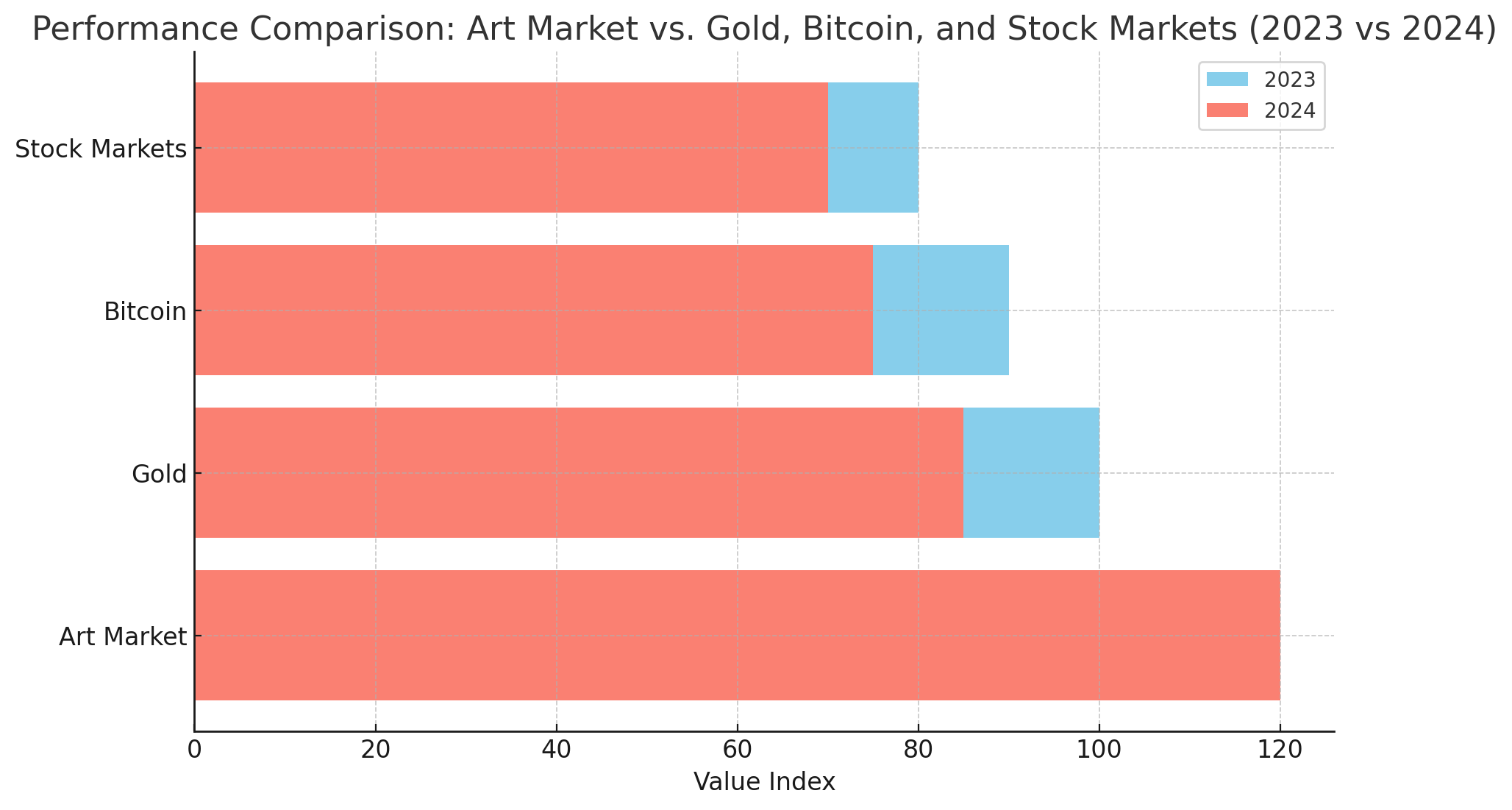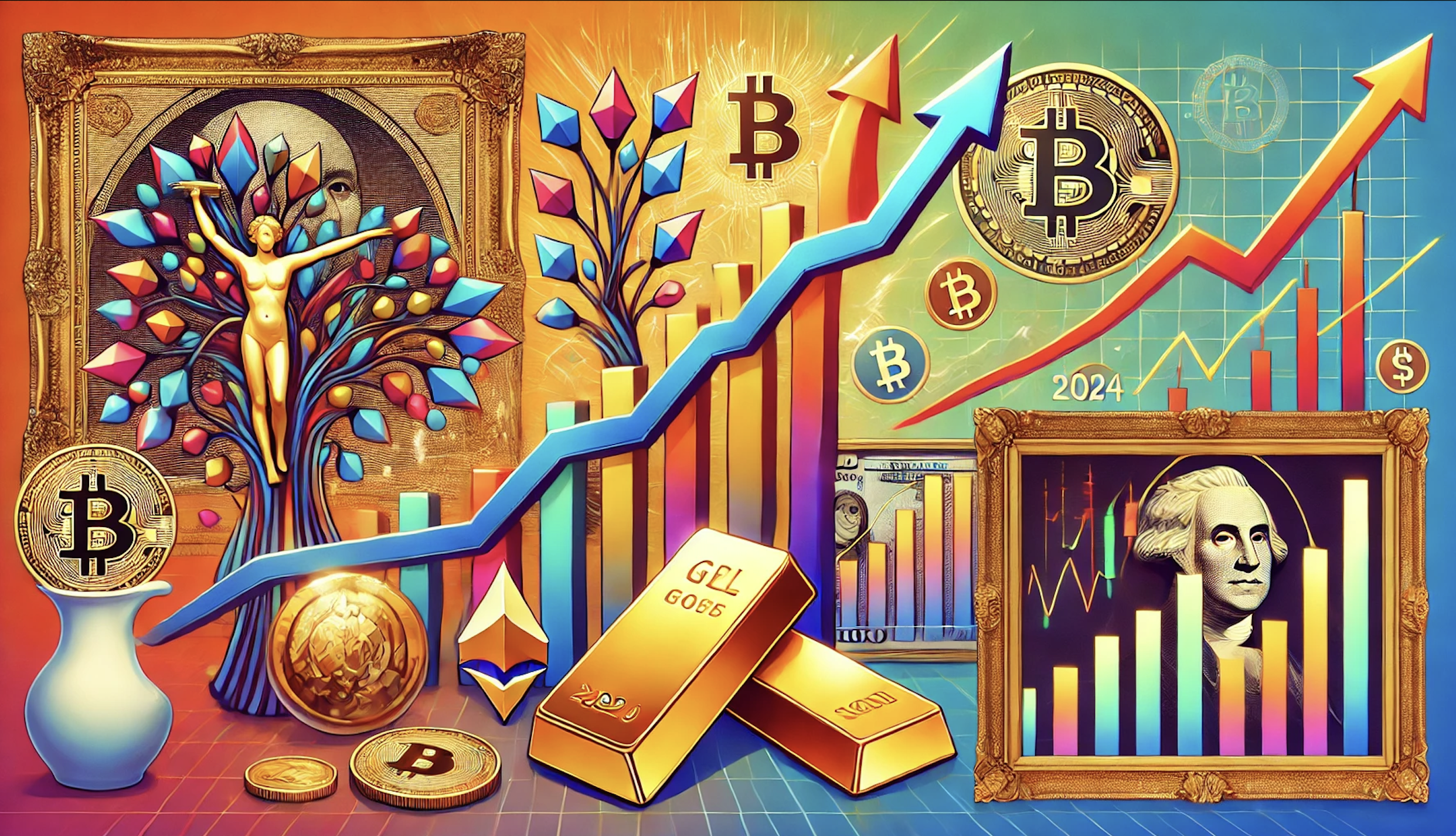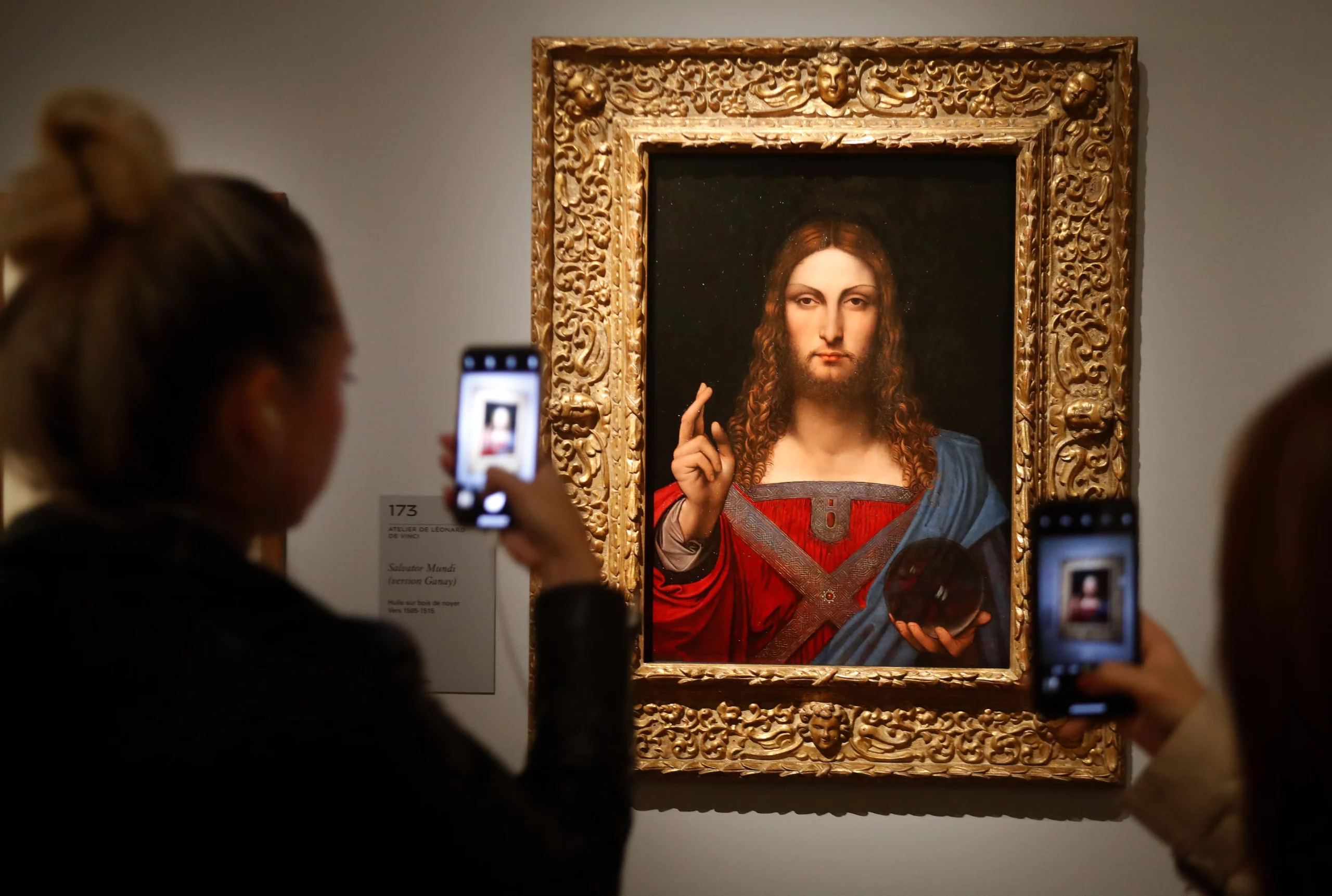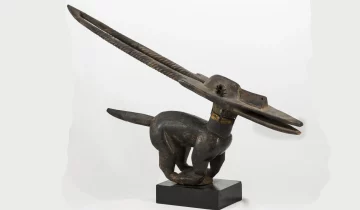Art Market Outpaces Gold and Bitcoin in 2024 Economic Downturn
In 2024, the global economic landscape is marked by turbulence and uncertainty. With Japan’s economy in a tailspin, stock markets in the USA and Europe plummeting, and both Bitcoin and gold experiencing significant declines, investors are seeking refuge in more stable assets. Amid this financial turmoil, the art market has emerged as an unexpected sanctuary of resilience and growth, outshining traditional and digital assets alike.
The art market’s robustness during these challenging times is not merely coincidental. According to the 28th Annual Report by Artprice from Artmarket.com, the art market has continued to thrive, setting new records and attracting a diverse range of buyers. This article explores why the art market has remained steadfast amid the economic downturn and how artists are capitalizing on this trend by selling art online.
The economic woes of 2024 have led to a reassessment of investment strategies. Traditional safe havens such as gold and emerging digital assets like Bitcoin have not provided the security investors once expected. Japan’s economic crash has had ripple effects worldwide, exacerbating the downturn in the USA and Europe. These financial struggles have made it increasingly challenging for investors to find stable and profitable opportunities.
Despite these headwinds, the art market has demonstrated remarkable resilience. The 2023 report by Artprice highlighted a record number of artworks sold at auction, with over one million works put up for auction and 763,000 transactions completed. This trend has continued into 2024, suggesting that the demand for art remains robust even in times of economic uncertainty.
Several factors contribute to the art market’s stability. First, art is seen as a tangible asset with intrinsic cultural and historical value, making it less susceptible to the volatility that affects financial markets. Unlike stocks or digital currencies, the value of art is not directly tied to market performance, providing a safe haven for investors seeking stability.
Moreover, the increasing accessibility of selling art online has opened up new opportunities for artists and collectors alike. Platforms for artists selling art online have proliferated, making it easier than ever to reach a global audience. This digital transformation has democratized the art market, allowing even beginners to sell their paintings online successfully. The best websites to sell art online offer user-friendly interfaces and robust marketing tools, enabling artists to connect with buyers from around the world.
For those looking to delve deeper into the intricacies of the art market, exploring the dynamics of investing in African art markets provides valuable insights. Understanding trends and opportunities within these markets can further enhance investment strategies, as highlighted in articles such as Investing in African Art: Market Trends and Opportunities and Mastering Art Investment in African Markets.
The art market’s resilience is also bolstered by the growing recognition and demand for works by female artists. The 2023 report noted a spectacular growth in auction sales for female artists, reflecting broader trends towards diversity and inclusion within the art world. This shift not only enhances the market’s appeal but also opens up new investment avenues for collectors seeking unique and culturally significant pieces.
While traditional and digital assets grapple with instability in 2024, the art market stands as a pillar of resilience. Its intrinsic value, coupled with the accessibility of selling art online, positions it as a compelling investment opportunity. As we navigate these uncertain times, the art market’s stability offers a beacon of hope and a testament to the enduring power of creativity and culture. For more detailed insights, exploring resources such as Africa’s Art Market Takes Off and Art Funds: Exploring Collective Investment in the Art Market can provide further guidance and inspiration.

Current Economic Climate
In 2024, the global economic environment has become increasingly volatile and unpredictable. Japan’s economy has experienced a significant downturn, leading to widespread financial instability. Similarly, stock markets in the USA and Europe have faced substantial declines, causing concern among investors. Traditional safe havens such as gold and digital assets like Bitcoin have also seen their values fall, challenging their roles as reliable investment assets.
Japan’s economic struggles can be attributed to several factors, including demographic challenges, slow economic growth, and the lingering effects of global supply chain disruptions. In the USA and Europe, inflationary pressures, geopolitical tensions, and the aftereffects of the COVID-19 pandemic have contributed to market contractions and investor unease. Bitcoin and other cryptocurrencies, once heralded as digital gold, have shown extreme volatility, leading many to question their reliability as stable investments.
Resilience of the Art Market
Amid this economic turmoil, the art market has shown remarkable resilience and even growth. According to the 28th Annual Report by Artprice from Artmarket.com, 2023 was a record-setting year for art auctions, with over one million artworks put up for sale and 763,000 transactions completed. This trend has continued into 2024, indicating robust demand for art despite broader economic uncertainties.
One of the most significant factors contributing to the art market’s resilience is its perception as a tangible asset with intrinsic cultural and historical value. Unlike stocks or cryptocurrencies, which can be highly volatile and subject to market fluctuations, art maintains its value through its uniqueness and cultural significance. This has made it an attractive investment for those looking to diversify their portfolios and hedge against economic instability.
The art market’s strength is also reflected in recent high-profile sales. For instance, one of the most expensive artworks sold in 2024 so far is a painting by Jean-Michel Basquiat, which fetched a staggering $110 million at auction. This sale underscores the continuing demand for significant works of art and the willingness of collectors to invest substantial sums in pieces they deem valuable. Other notable sales include a piece by Gerhard Richter that sold for $80 million and a Banksy artwork that achieved $50 million, further highlighting the art market’s buoyancy. For more details on these record-breaking sales, visit Belart Gallery.
Selling Art Online: A Growing Trend
The shift towards digital platforms has also played a crucial role in the art market’s resilience. Selling art online has become increasingly popular, providing artists and collectors with new opportunities to reach global audiences. The best ways to sell art online include using established platforms that offer robust marketing tools and user-friendly interfaces, making it easier for artists to connect with potential buyers.
For artists selling art online, platforms such as Artsy, Saatchi Art, MoMAA and Etsy have become invaluable. These websites provide a global marketplace where artists can showcase their work, manage sales, and reach a diverse audience. This digital transformation has not only democratized the art market but also increased its accessibility, allowing even beginners to successfully sell their paintings online.
For those new to selling art online, resources like Africa’s Art Market Takes Off and Investing in African Art: Market Trends and Opportunities offer valuable insights into navigating the online art market. These guides provide practical advice on how to effectively market and sell art, ensuring that artists can maximize their reach and profitability.
Case Study: African Art Market
The African art market serves as a compelling case study for the potential of online art sales. Historically underrepresented in the global market, African artists are now gaining significant recognition and achieving record sales. The rise of digital platforms has played a crucial role in this transformation, allowing African artists to reach international audiences and attract major collectors.
For example, Nigerian artist Njideka Akunyili Crosby has seen her work fetch impressive prices at auction, with pieces selling for over $3 million. This success highlights the growing interest in African art and the effectiveness of online platforms in bringing these works to a broader market. For more insights on the African art market, articles such as Mastering Art Investment in African Markets provide a comprehensive overview of the trends and opportunities in this burgeoning market.
Strategies for Artists: Selling Art Online
For artists looking to capitalize on the art market’s resilience, selling art online presents a multitude of opportunities. Here are some strategies to consider:
1. Utilize Multiple Platforms: Diversifying the platforms used to sell art online can increase visibility and reach. Popular sites like Artsy, Saatchi Art, and Etsy each have unique audiences and benefits.
2. Optimize Online Presence: A strong online presence is crucial. Artists should invest in professional websites and social media profiles to showcase their work and engage with potential buyers.
3. Leverage Keywords: Using relevant keywords such as “sell your art online,” “best place to sell art,” and “selling art from home” can enhance search engine optimization (SEO) and drive more traffic to online listings.
4. Engage with the Community: Building relationships within the online art community can lead to collaborations, increased exposure, and potential sales. Participating in online forums, webinars, and virtual exhibitions can be beneficial.
5. Offer Diverse Price Points: Providing artworks at various price points can attract a wider range of buyers, from novice collectors to seasoned investors.
For more detailed guidance on selling art online, beginners can refer to resources like Art Funds: Exploring Collective Investment in the Art Market, which offers insights into the financial aspects of art investment and sales.
Market Trends and Future Outlook
The art market’s performance in 2024 provides valuable insights into its future trajectory. Despite the economic downturn, the market’s ability to attract new buyers and maintain high transaction volumes suggests a strong and stable outlook. Several trends are likely to shape the art market’s future:
1. Digital Transformation: The shift towards online sales and digital platforms is expected to continue, further democratizing the market and expanding its reach. This transformation will likely lead to increased competition among platforms, driving innovation and improved services for artists and buyers.
2. Increasing Diversity: The growing recognition of female artists and artists from underrepresented regions, such as Africa, will continue to diversify the market. This trend not only enhances the market’s appeal but also broadens the range of available artworks, attracting a more diverse collector base.
3. Sustainable Practices: As environmental concerns become more prominent, the art market may see a shift towards sustainable practices. This could include the use of eco-friendly materials, digital art forms, and sustainable packaging and shipping methods.
4. New Buyer Demographics: Younger generations, particularly millennials and Gen Z, are becoming increasingly active in the art market. These new buyers are tech-savvy, value-driven, and interested in contemporary and digital art forms. Their participation will likely drive future market trends and demand.
For a deeper understanding of these trends and their implications, resources like African Art Market Trends: What to Expect in 2023 offer valuable perspectives on market dynamics and future developments.
In a year marked by economic instability, the art market has stood out as a pillar of resilience and growth. Its performance in 2024, characterized by record transactions and high-profile sales, underscores its potential as a stable and lucrative investment avenue. The shift towards online sales has democratized the market, providing new opportunities for artists and collectors alike.
As traditional and digital assets grapple with volatility, the art market’s stability offers a beacon of hope and a testament to the enduring power of creativity and culture. By embracing the opportunities presented by selling art online, artists can navigate these uncertain times with confidence and success. For those interested in further exploring the art market’s potential, articles such as Art Funds: Exploring Collective Investment in the Art Market provide valuable insights into collective investment strategies and market trends.

In a year marked by significant economic instability, the art market has emerged as a beacon of resilience and growth. Despite the downturns affecting traditional and digital assets, the art market has continued to thrive, setting records in transactions and high-profile sales. The shift towards online platforms has democratized the market, providing artists and collectors with new opportunities to engage and prosper.
As we navigate the uncertainties of 2024, the art market’s stability and potential for continued growth offer a compelling investment opportunity. By leveraging digital tools and embracing the evolving landscape, artists and investors can find success and security in the enduring value of art. For those looking to delve deeper into the intricacies and opportunities of the art market, resources such as Investing in African Art: Market Trends and Opportunities and Art Funds: Exploring Collective Investment in the Art Market provide invaluable insights and guidance.





 No products in the basket.
No products in the basket.